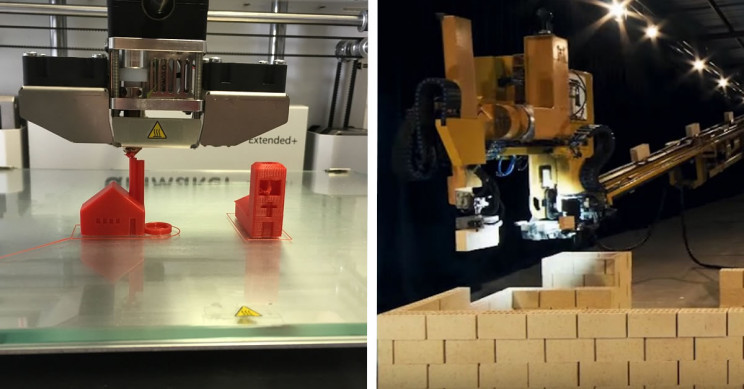7 Construction Industry Trends to Watch in 2020
 Construction Trend
Construction Trend
Article Link: https://interestingengineering.com/7-construction-industry-trends-to-watch-in-2020
By: Christopher McFadden
What construction tech trends should you keep an eye on in 2020? These 7 might be the most exciting.
What are the current trends in the building market?
We’ll expand on a few of these later in the article, but according to sites like ESUB, here are some of the most notable tech trends in the construction industry at the moment: –
- Technology Advancements and Integration.
- Green Technology in Construction.
- Increase in Modular and prefabricated Construction Projects.
- Increasing Material Cost.
- Decreased Labor Force.
- Better Safety Equipment.
- Sustainability.
What technology is used in construction?
Despite the construction industry’s traditional resistance to new technologies, some are making significant strides in rounds. Notable examples include, but are not limited to: –
- Mobile Technology.
- Drones.
- Building Information Monitoring (BIM).
- Virtual Reality and Wearables.
- 3D Printing.
- Artificial Intelligence.
What construction tech trends should you watch in 2020?
So, without further ado, here are 7 tech trends you might want to watch in 2020.
1. Virtual reality (VR), augmented reality (AR) and mixed reality (MR)
These technologies are already making a huge impact on many industries around the world, and the construction industry is no exception. Buildings are becoming ever more complicated, and these technologies are helping architects and construction teams improve designs and detect design errors.
To date, architects and design teams greatly improve building design through interactive design and gesture interfacing. 2020 is set to see this technology’s influence on the industry expand even further.
This could range from errors in HVAC system design or finding missing elements that have been overlooked during the design phase. AR, VR, and MR are also being utilized in the construction industry to aid: –
- 3D modeling of buildings and structures.
- Helping improve and innovate BIM visualization.
- It helps provide a permanent record of the building and allows clients to explore designs before construction.
- Helping “see through walls” for maintenance workers and service engineers.
2. 3D printing
Another tech trend to watch out for in 2020 is the role of 3D printing in the construction industry. The benefits of it have already been explored and exploited by various construction companies around the world.
The ability to either prefabricate offsite or directly on-site has obvious labor and material cost benefits over more traditional building methods. It also reduces waste and being automated is not restricted by construction worker shift patterns.
For example, today it’s possible to 3D print an entire house in less than 24 hours!
“The concrete 3D printing market is expected to reach $56.4m in 2021, and with good reason. More and more companies are starting up in the sector to create new, innovative projects. Some are more futuristic, some are very real in the present, such as Apis Cor’s 3D printed house in 24 hours. 3D concrete printing is developing rapidly and relies on different technologies and materials, offering many benefits to its users. The tech is still in its infancy however and is bound by current limitations.” – 3D Natives.
3. Robotics
2020 may also be the year where robotics makes a bigger impact in the construction industry. Somewhat linked to the impact of 3D printing above, robotics is also seeing impressive infiltration into the industry.
In fact, one report by the World Economic Forum predicted that 2020 could be the year of the robot in the construction industry.
From robotic bricklayers to laying roads, robots are increasingly finding their place amongst the workforce on construction sites. This is interesting as traditionally the construction industry has seen very little automation, relying largely on manual labor.
By adding robots to the workforce, construction companies are seeing improved construction times and improved quality of builds. Robots are also being used to help demolish buildings too.
While currently slower than human demolition crews, they are far safer and cheaper for bringing down concrete structures at the end of its life cycle.
Robots are also being developed to help with certain building maintenance like window cleaning.
4. Sustainability
For several decades now, building regulations have been placing more and more burden on building design to reduce their environmental impact and sustainability. This is a trend that will only become more strict heading into 2020 and beyond.
Optimized energy efficiency and a drive for low to zero carbon emissions have driven innovation in building construction and service design for years. In response, new, better thermal performance materials are being developed that promise to make the buildings of the future incredibly well insulated for a fraction of the cost of current solutions.
One example from a few years ago was the development of a concrete roof that can generate and store energy. Innovations like this should make buildings of the future cheaper to live in and reduce their impact on the environment.
Reducing waste or recycling old materials is another area where sustainability is helping drive innovation in the construction industry. For example, last year one architecture firm announced its plans for a new method of recycling construction waste into ton new reusable building materials.
It will be interesting to see what new innovations will be realized in 2020.
5. Modular and Prefabricated Construction
Modular and prefabricated solutions are nothing new to the construction industry. For example, the end of the Second World War saw something of a ‘Cambrian Explosion’ in prefab design in war-torn cities across the UK.
While it has fallen out of favor over the last few decades, prefabs have been making something of a comeback in recent years. The promise of faster on-site assembly and higher quality, standardized builds are seen by some as the solution to tackle perceived housing crises around the world.
“Advances in high-tech design and construction mean increasing numbers of components can be manufactured off-site. That means buildings can go up more quickly and quietly, with fewer materials wasted – an enticing prospect given London’s housing crisis.
To accommodate modular house-building, developers are building their own factories, and architects are getting ever more ambitious in their designs. Here are five of our favorite London modular housing designs.” – The Spaces.
6. Exoskeletons
Another tech trend to watch in 2020 is the use of exoskeletons. The potential benefits this can afford to a construction site’s workforce are obvious.
Laborers can carry more load than their fragile human bodies would normally be able to cope with, and if it is widely adopted, it would largely increase the safety of construction sites. For construction companies, this will dramatically improve their bottom line by reducing the number of laborers needed on-site as well as reduce lost man-hours from injury.
“ABI Research predicts the robotic exoskeleton market alone will reach $1.8 billion in 2025, up from $68 million in 2014. This year, about 6,000 suits will be sold, mainly for rehabilitation. By 2025, ABI expects to see about 2.6 million on the market.” – Constructible.
But they may ultimately lose out to robots and 3D printing alternatives as exoskeletons still rely on a human operator at their heart. That being said, they might offer the perfect compromise between labor unions who will inevitably try to protect their member’s jobs from becoming obsolete.
But they are yet to significantly infiltrate the industry. Perhaps 2020 will be the year they make it?
Time will tell.
7. Building information modeling
Building Information Modelling, or BIM for short, is a process of creating and managing information on a construction project from cradle to grave. This intelligent 3D model-based process has already seen wide adoption by architects, engineers, and other construction professionals.
In fact, many local authorities have made BIM the standard for many of its construction project needs. BIM allows stakeholders and suppliers to more efficiently plan, design construct and manage a building and its infrastructure.
As other technologies already mentioned, like AR, and VR, become more popular, their integration with BIM will become ever more important. This is unlikely to slow down in 2020 and beyond.

Professional Recruiter Associates